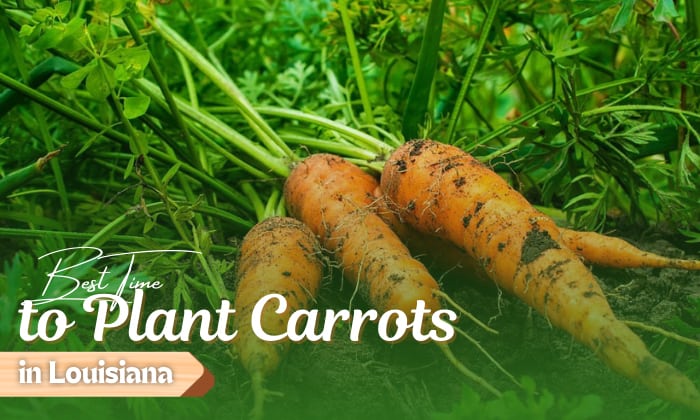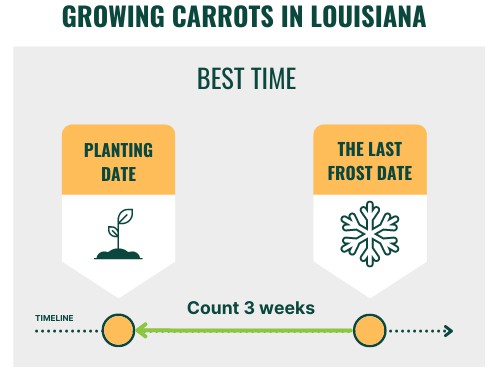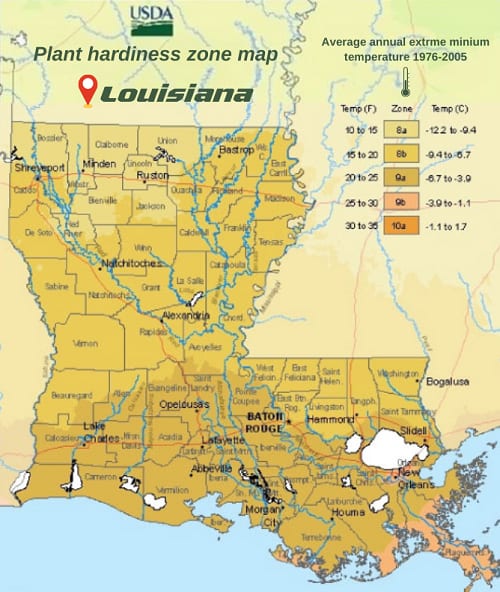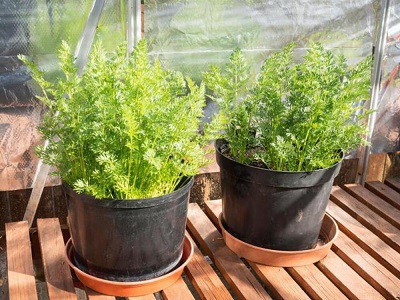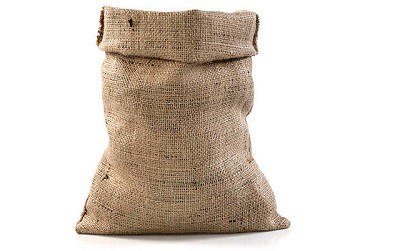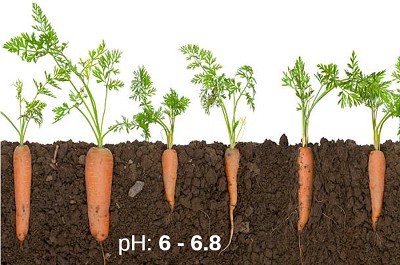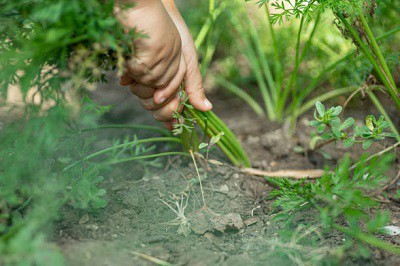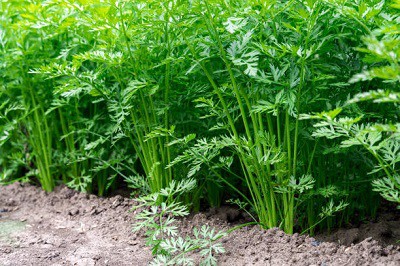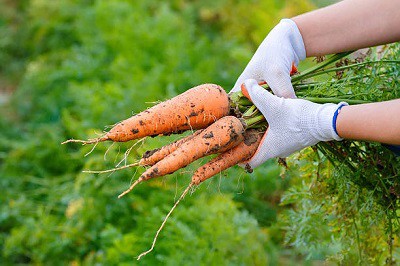A good time to plant carrots in Louisiana is around January 15 to February 15 and September 1 to November 1, though the dates can vary depending on the hardiness zone you are in. The section below answers the question, “when to plant carrots in Louisiana?” in greater detail with a zone-wise breakup.
We’ll also provide more tips on caring for these vegetables, so read on.
Table of Contents
Best Time to Plant Carrots in Louisiana
US states are divided into hardiness zones according to the annual minimum temperature they experience. Therefore, different hardiness zones of Louisiana have different carrot planting times, as described below.
- Zone 8: March 7
- Zone 9: February 9
- Zone 10: January 1
You might wonder why these dates are given.
The reason is that carrots should be planted approximately 3 weeks before the last frost date, and since Louisiana has hardiness zone 8 to 10, we have the table below.
| Zones in Louisiana | Last frost date in zones | Suggested planting date |
| Zone 8 | March 28 | March 7 |
| Zone 9 | February 28 | February 7 |
| Zone 10 | No frost usually | January 1 |
The table above offers a planting schedule that will help, whether you are in zone 8 or zone 9, but a few additional parameters can impact these dates, such as the city you live in.
We have estimated the planting time for some cities in Louisiana below:
| Cities in Louisiana | Last frost date | Suggested planting date | First frost date |
| New Orleans | February 16 | January 26 | December 19 |
| Baton Rouge | March 7 | February 15 | November 17 |
| Shreveport | |||
| Metairie | February 2 | January 12 | December 23 |
| Lafayette | February 26 | February 5 | November 26 |
| Lake Charles | November 28 | ||
| Kenner | February 8 | January 18 | December 17 |
| Bossier City | March 7 | February 15 | November 16 |
| Monroe | March 14 | February 22 | November 8 |
| Alexandria | March 6 | February 14 | November 18 |
Aside from the last frost in spring, it’s also vital to look up your first frost and put carrots in the ground ten weeks before it. This timeframe will allow your crops to mature and become harvestable before winter arrives.
Considering that Louisiana welcomes freezing weather around November 11 to January 10, fall planting from September to November makes sense.
What to Do if a Frost Occurs After Planting Carrots?
Even when you time the planting right, frost can occur after sowing. In that case, you have 2 solutions.
Solution 1: Bring pots indoors
Are the carrots in pots? If yes, simply shifting the pots to the inside of your home or garage will isolate them from the extremely cold temperature outside.
Solution 2: Use burlap
If shifting them inside isn’t possible, use burlap to shield them from the outside weather. Using burlap is relatively easy when you follow the tips below.
- Use burlap to cover the plant, but don’t let it touch the foliage.
- Insert stakes into the soil to hold the fabric up, and remove the burlap once the weather turns warm.
Want an alternate solution?
Replace burlap with old blankets and sheets held together using staples and stakes.
Tips for Growing Carrots Successfully in Louisiana
With planting and protection covered, the section below provides some handy tips to help grow carrots in Louisiana.
1. Ensure proper watering and soil conditions.
Carrots need moist soil with a pH level between 6 and 6.8. It’s best to water carrot plants once a week so that the uppermost layer of the ground is damp. However, strictly avoid waterlogging. A simple test is to poke your finger one inch into the soil; if the surface is moist, there is no need to water it yet.
2. Eliminate weeds.
Carrots take a long time to germinate and grow. Any weed growth can impact the yield as the plant has to compete with weeds for nutrients. To avoid such a situation, use a weed removal tool like a puller or trowel. Just ensure you don’t disturb the roots while uprooting the weeds.
3. Use fertilizer sparingly.
Carrot plants do not need a lot of fertilizer. When using any fertilizer, reduce the recommended manufacturer’s quantity by half. But the question is, which nutrients do carrot plants need the most?
Carrot plants need potassium and phosphates the most, so select a 5-10-10 or other low-nitrogen formulas according to your soil test.
Watering the ground after spreading the fertilizer will help it soak in.
4. Thin the carrots
Thinning carrots refers to removing some carrot plants to provide space for other seedlings to grow. To thin carrots the right way, follow the tips below:
- Ideally, you should thin carrots in early summer when there are 3 to 4 leaves per plant.
- Using scissors is a good way to trim carrot seedlings so that they are at least 4 cm apart. After cutting the leaves, ensure you pull out the plants at an angle to avoid damaging adjacent
- It’s best to thin carrots twice a season.
Note:
Carrots removed from soil during thinning can be eaten or added to compost.
5. Harvest them right
Usually, carrots can take anywhere from 75 to 80 days to mature (refer to the table below). There are a few signs which let you know if a carrot is ready for harvest or not.
- A root size of 1 inch in diameter indicates carrot plants have matured.
- Taste a single carrot. If it’s tender and sweet, the entire crop is ready for harvest.
| Carrot types suitable for Louisiana | Maturity time frame |
| Chantenay Red Core | Up to 75 days |
| Danvers | Up to 75 days |
| Imperator | Up to 80 days |
| Bolero | Up to 80 days |
| Nantes | Up to 75 days |
Conclusion
With our detailed Louisiana planting guide by month above, the question of ”when to plant carrots in Louisiana” will no longer puzzle you. Whether you are in South Louisiana or any other part, refer to the zone map and guidelines above, and you will know the best dates to plant carrots.

Hi, I am William – Floridayards’ digital content creator. My job is to find answers to all your concerns with thorough research and our team’s expert advice. I will also bring you honest reviews on the best products and equipment for raising your beautiful garden. Please look forward to our work!


